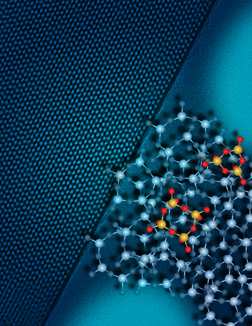NEWS RELEASES
FOR IMMEDIATE RELEASE
July 9, 2007
Self-assembled nanostructures function better than bone as porosity increases
Improved possibilities for microelectronics, membranes
 On the left is a TEM micrograph of a porous, cube-like nanostructure. On the right is a blow-up of the silica framework (the dark <2-nm thick regions on the left side figure) based on modeling. The highlighted structures represent the small rings referred to in the news release.
On the left is a TEM micrograph of a porous, cube-like nanostructure. On the right is a blow-up of the silica framework (the dark <2-nm thick regions on the left side figure) based on modeling. The highlighted structures represent the small rings referred to in the news release. Download 300dpi JPEG image, “selfassemnano_nr.jpg,” 1.9MB (Media are welcome to download/publish this image with related news stories.)
ALBUQUERQUE, N.M. —Naturally occurring structures like birds’ bones or tree trunks are thought to have evolved over eons to reach the best possible balance between stiffness and density.
But in a June paper in Nature Materials, researchers at Sandia National Laboratories and the University of New Mexico (UNM), in conjunction with researchers at Case Western Reserve and Princeton Universities, show that nanoscale materials self-assembled in artificially determined patterns can improve upon nature’s designs.
“Using self-assembly we can construct silica materials at a finer scale than those found in nature,” says principal investigator Jeff Brinker. “Because, at very small dimensions, the structure and mechanical properties of the materials change, facile fabrication of stiff, porous materials needed for microelectronics and membrane applications may be possible.”
Sandia is a National Nuclear Security Administration laboratory.
Nuclear magnetic resonance and Raman spectroscopic studies performed by Sandia researchers Roger Assink (ret.) and Dave Tallant, along with molecular modeling studies performed by Dan Lacks at Case Western Reserve University, showed that, as the ordered porous films became more porous, the silica pore walls thinned below 2 nm, re-arranging the silica framework to become denser and stiffer.
Whereas the stiffness of evolved optimized bone declines proportional to the square of its density, mechanical studies performed by Sandia researcher Thomas Buchheit working with UNM student Christopher Hartshorn showed that the stiffness/modulus of self-assembled materials was much less sensitive to increasing porosity: For a material synthesized with a cubic arrangement of pores, the modulus declined only as the square root of its density.
The silica nanostructures — basically a synthetic analogue of bone-like cellular structures, replicated at the nanoscale using silica compounds — thus may improve performance where increased pore volume is important. These include modern thin-film applications such as membrane barriers, molecular recognition sensors, and low-dielectric-constant insulators needed for future generation of microelectronic devices.
“Bone, closely examined, is a structured cellular material,” says Brinker, a Sandia Fellow and chemical engineering professor at UNM. “Because, using self-assembly, we had demonstrated the fabrication of a variety of ordered cellular materials at the nanoscale with worm-like (curving cylinders), hexagonal (soda straw packing) and cubic sphere arrangements of pores, we wondered whether the modulus-density scaling relationships of these nanoscale materials would be similar to the optimized evolved materials [like bone]. We found that both material structure and pore sizes matter. At all densities we observed that the cubic arrangement was stiffer than the hexagonal arrangement, which was stiffer than the worm-like. For each of these structures, increasing porosity caused a reduction in modulus, but the reduction was less than for theoretically optimized or naturally evolved materials due to the attendant stiffening of the thinning nanoscale silica walls resulting from the formation of small stiff silica rings.
“This change in ring structure only happens at the nanoscale,” says Brinker.
Sandia researcher Hongyou Fan created cubic, cylindrical, and worm-like (or disordered) pores to evaluate differences in stiffness resulting from these differently shaped internal spaces.
Other paper authors include Dave Kissel of UNM, Regina Simpson at Sandia, and Salvatore Torquato of Princeton.
Funding for the research was provided by DOE’s Office of Science and Sandia’s Laboratory Directed Research and Development Program.
Sandia is a multiprogram laboratory operated by Sandia Corporation, a Lockheed Martin company, for the U.S. Department of Energy’s National Nuclear Security Administration. With main facilities in Albuquerque, N.M., and Livermore, Calif., Sandia has major R&D responsibilities in national security, energy and environmental technologies, and economic competitiveness.
Sandia news media contact: Neal Singer, nsinger@sandia.gov, (505) 845-7078